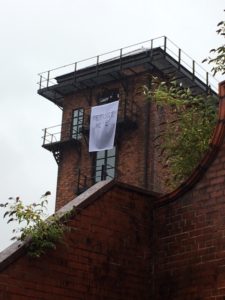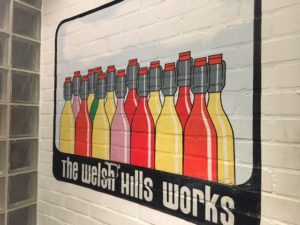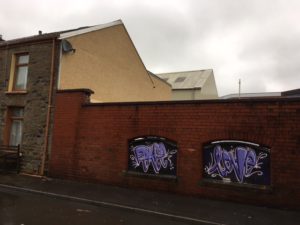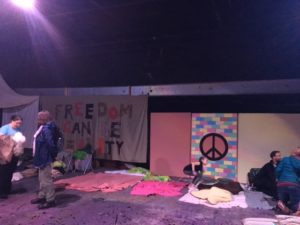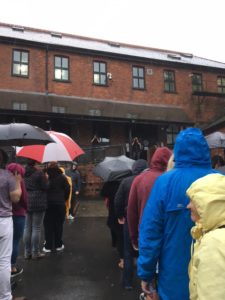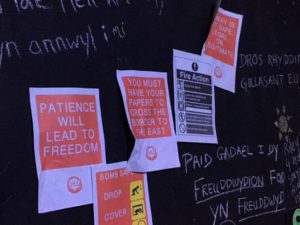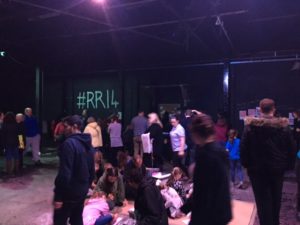 (4 / 5)
(4 / 5)
Cheer by Kitty Hughes is a dystopian, anti-panto where Christmas is controlled by the elite and briefly experienced by the poor through the Christmas drug, ‘cheer’.
We follow Jules (Alice Downing) on a journey of exploring her own morality. Jules sells illegal Christmas licenses, seeing herself as a Robin Hood figure, but operating more like Sports Direct, TK Maxx or one of those Gucci knock-off labels. Offering cheap alternatives to allow the poor to join in on the rich people’s rampant consumerism. Enabling and in essence supporting the elite.
When Todd (Cory Tucker) enters, Jules is forced to recognise her hypocrisy as someone who understands the oppressive system, but merely profiteers off the desires of the poor.
One thing Kitty Hughes does well in the script, is neither character is particularly likeable. Jules is clearly exploitative and, despite being relatable in many ways, flawed. We would all like to say, “I’m not like that,” but ultimately if you can afford Christmas, you undoubtedly will relate in some way to her moral conundrum.
One main criticism has to come with Todd’s character. He doesn’t really have a story and is more of an event in Jules’ story. A statement in itself. But one that is potentially problematic. He goes in wanting one thing and comes out with it and despite recognising the over-consumption and greed of it all, he still wants to participate. And that is his position going in. He doesn’t learn a lot and really, at its heart this is a story about the moral dilemma of left-wing, middle class person. A conversation urgently needed in theatre, so good that it’s being had here. But perhaps a stronger working-class character, with more of a story would make this production more powerful.
It’s a play that explicitly talks about class, in a way that really isn’t very dystopian at all. Some people can’t afford Christmas, this is simply a reality. But also, it’s a script you can interpret in various ways. General classism, how the “first” world treats the “third” world in terms of aid, or even migration. The play feels a lot more real than a lot of dystopian pieces that speak in metaphor or allegory. This is more literal and stronger for it.
The script certainly gets a little lost in repeating itself. It seems to drag and with less of the playful style Big Loop usually adopt, 85-minutes does seem too long to tell this story. Especially as it feels as though you could pack this into an hour very easily. That said, the scenes themselves are well written, and you don’t get bored. But in terms of a script, it could be planned and plotted better.
Not Duncan Hallis’ most playful piece of direction, he shows that he can handle a heavy piece without compromising his style too much.
Perhaps one of the main downfalls of this production is, it sometimes feels like we’re split between Hallis’ imagination and Hughes’ political conscience. Sometimes it gets a little cluttered and the drama gets lost.
However, this conflict of style isn’t always a negative. The direction sometimes distracts from the deeply political text in a way that makes the message sink deeper. For example, when the two characters are arguing about their backgrounds, an exchange that is packed with political language, it’s a complete mess.
But a mess in a good way. It seems real. There’s a lot of frustration in this argument and the two characters are not exactly in the mindset in that moment to string together coherent political points. It comes from the character’s heart in a way that we don’t really see elsewhere, particularly from Todd, in the production. And so despite the political language, the manic actions and energy make it seem as if they’re just shouting and rambling, despite making thought-out political points. There’s a complete contradiction between what we see and hear that works really well.
The combination of styles is really good and a writer-director team I’d like to see more of. It just would have been nice to see some more weird, wacky or surreal moments from Hallis’ mind at times.
Alice Downing shows a lot of depth in her complex character. She exploits a brilliant use of facial expressions and body language to portray her character’s inner emotions.
Cory Tucker doesn’t have the same amount of character depth to play with, but does a good job of depicting what is there for his character. In particular, Tucker’s attention to detail in certain moments, the first time he tries gingerbread or the first time we see him on ‘cheer’, stand out. Considering there’s not much depth to his character, Tucker does a good job of letting us know the important moments for Todd.
The set design from Ceci Calf is really nice. The classic bookshelf/cupboard the best bit, but it’s just generally a nicely decorated set. The lighting design by Garrin Clarke compliments the production well. Lights changing and flashing when characters are on ‘cheer’ and a projection of a crazy Father Christmas onto the set in particular stand out.
The sound design from Matthew Holmquist shows a great use of music in particular. A bit of a throwback to earlier in the year when Cardiff Boy, which Holmquist directed, took over The Other Room. Again we see the influence of Holmquist’s mix of music to emphasise what’s happening on stage.
Generally, the productions is enjoyable and funny, as well as deeply political and thought provoking. A protagonist with a clear moral dilemma that isn’t solved by the end is left at a satisfactory conclusion encouraging the audience to discuss further after the show. And isn’t that exactly what theatre should be about?
Cheer is a bleak outlook on the world and Christmas, but has messages and themes that really should be spoken about further than just in the theatre. It’s a brave production that won’t fail to get a reaction from anyone.
Cheer at The Other Room.
Running November 27th – December 15th
Produced by Big Loop Theatre Company
Written by Kitty Hughes
Directed by Duncan Hallis
Starring:
Alice Downing as Jules
Cory Tucker as Todd
Creative Producer: George Soave
Designer: Ceci Calf
Lighting Designer: Garrin Clarke
Sound Designer/Composer: Matthew Holmquist
Stage Manager: Kitty Hughes
Assistant Producer: Yasmin Williams
Assistant Director: Alanna Iddon
Arts Placement: Natasha Grabauskas
Set Construction: Jack Calf
Promo from Sean Cox Design
Photography from Tess Seymour Photography

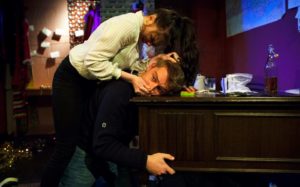
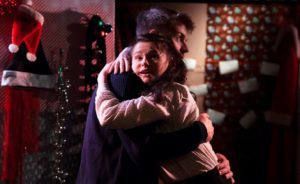
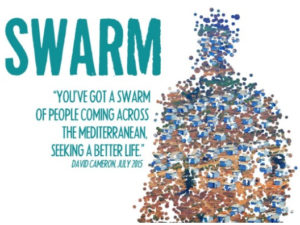
 (5 / 5)
(5 / 5)